Canon Powershot S70By: Dave EtchellsWith the same wide angle lens as its predecessor, the S70 boosts resolution with its 7.1 megapixel sensor, but holds the line on image noise. <<S70 Sample Images :(Previous) | (Next): Print-Friendly Review Version>> S70 Imatest ResultsReview First Posted: 9/30/2004 |
Detailed analysis of the Canon PowerShot S70 images, from Imatest(tm)
I've recently begun using Norman Koren's excellent "Imatest" analysis program for quantitative, thoroughly objective analysis of digicam test images. I highly commend it to our technically-oriented readers, as it's far and away the best, most comprehensive analysis program I've found to date. (And with an introductory price of only $59, it's hard to beat.)
My comments below are just brief observations of what I see in the Imatest results. A full discussion of all the data Imatest produces is really beyond the scope of this review: Visit the Imatest web site for a full discussion of what the program measures, how it performs its computations, and how to interpret its output.
Here's some of the results produced by Imatest for the Canon PowerShot S70:
Color Accuracy
The Canon PowerShot S70 has what I've come to recognize as characteristically
"Canon" color. Namely, a slight saturation boost overall (in keeping
with general practice for consumer digicams), with a bigger boost on reds,
and a hue shift of cyan shades more toward the blue realm. In the chart above,
oversaturation is shown by the extent to which the circles (camera color)
are displaced outward (higher saturation) relative to the ideal values (squares).
Interestingly though, the S70's color is a little more "consumer-y"
than that of the G6. Specifically, its color is a little more saturated and
brighter looking, with an average saturation level of 117.3%, vs the G6's
110.7%. Saturation is slightly higher pretty much across the board, but the
biggest difference is in the greens. - Foliage will tend to look brighter
and/or richer with the S70, vs the G6.The modest oversaturation is pretty
typical of consumer digicams, and not a cause for concern. Possibly more problematic
is the hue shift seen in cyan colors, (the points numbered 6 and 18 in the
chart above), which tends to move shades of cyan more toward blue tones. Interestingly,
I didn't see much evidence of this in my shooting with the camera (or in other
Canon cameras I've shot with, and seen the same color shift in), I suspect
the main effect would be to produce richer blues in sky colors, something
most consumers would probably like.
Color Analysis
These images show the color behavior of the PowerShot S70 directly. In each color swatch, the outer perimeter shows the color as actually captured by the camera, the inner square shows the color after correcting for the luminance of the photographed chart (as determined by a 2nd-order curve fit to the values of the gray swatches), and the small rectangle inside the inner square shows what the color should actually be, based on perfect rendering to the sRGB color space.
As is commonly the case in digicams I test, it seems that at least some of
the oversaturation arises from the camera's rather contrasty tone curve. It
does show the effect of the characteristic hue shift in the cyans and blues
that Canon uses to achieve more attractive sky colors, with the camera reproducing
those colors as a little "richer looking" than in real life.
Gray Patch Tone and Noise Analysis
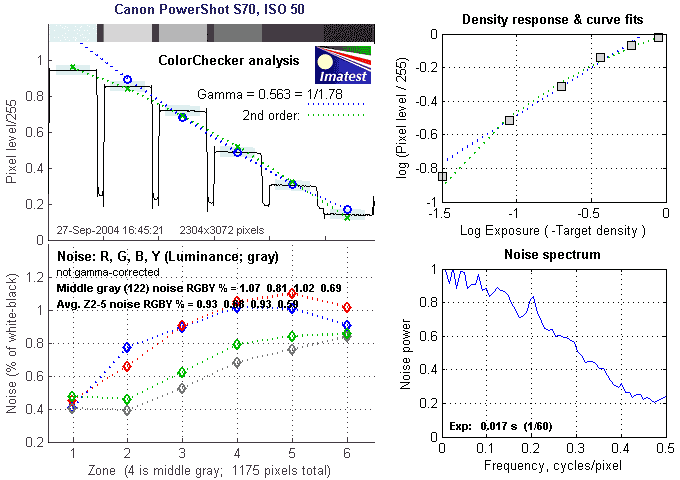
There's a lot in this particular graph, a lot more than I have room to go into
here. Bottom line, the PowerShot S70's noise levels are pretty low across the
board, and fairly fine-grained, particularly at low ISO settings. (The S70's
noise develops a bit larger grain size at higher ISOs, making its noise pattern
there a bit more evident to the eye.)
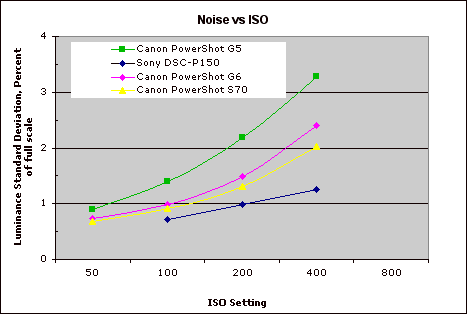
This chart compares the PowerShot S70's noise performance over a range of ISOs
against that of other cameras. The G5 is shown for the sake of historical comparison:
It's interesting that both the G6 and S70 have lower noise levels than the G5,
even though their CCDs have smaller pixels. A lot of what this chart is showing
though, is the difference in anti-noise processing, and some of the most important
information doesn't appear here. Namely, the impact that anti-noise processing
has on subtle subject detail. The G6 and S70 both use the same CCD chip (and
I believe the Sony P150 does as well), so the slightly lower noise levels shown
in the chart above for the S70 have to come from more aggressive anti-noise
processing. This in fact appears to be the case, as I found that the S70 had
a slightly greater tendency to flatten-out subject detail in areas of
subtle contrast than did the G6. Likewise the Sony P150, only more so: The P150's
noise is indeed noticeably lower in magnitude, but that camera is much more
likely to lose subtle detail in hair, foliage, etc. Of the three, I prefer the
G6's approach to noise reduction, but the S70 runs a close second.
The chart above shows consolidated results from spatial frequency response
measurements in both the horizontal and vertical axes. The "MTF 50"
numbers tend to correlate best with visual perceptions of sharpness, so those
are what I focus on here. Imatest reported uncorrected resolution figures of
1305 line widths per picture height in the horizontal direction (corresponding
to the vertically-oriented edge), and 1283 along the vertical axis (corresponding
to the horizontally-oriented edge), for a combined average of 1294 LW/PH. Correcting
to a "standardized" sharpening with a one-pixel radius increased both
numbers a fair bit, resulting in a corrected average of 1573 LW/PH, actually
just slightly better than the corresponding 1523 LW/PH I found for the G6. (Per
the note from Imatest above, the black level was clipping very slightly
on this res target shot, which would have the result of pushing the LW/PH numbers
slightly higher than their actual values. This could account for some of the
S70's slightly better performance than the G6 here, but the amount of clipping
is really very minor (only about 1% on the vertical edge), so I didn't bother
reshooting the test target.)
For the real techno-geeks, the two plots below show the actual edge response
of the S70, for horizontal and vertical edges:
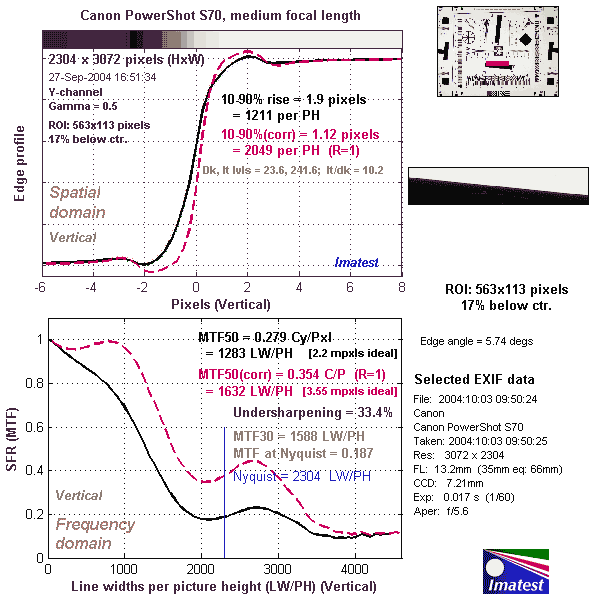
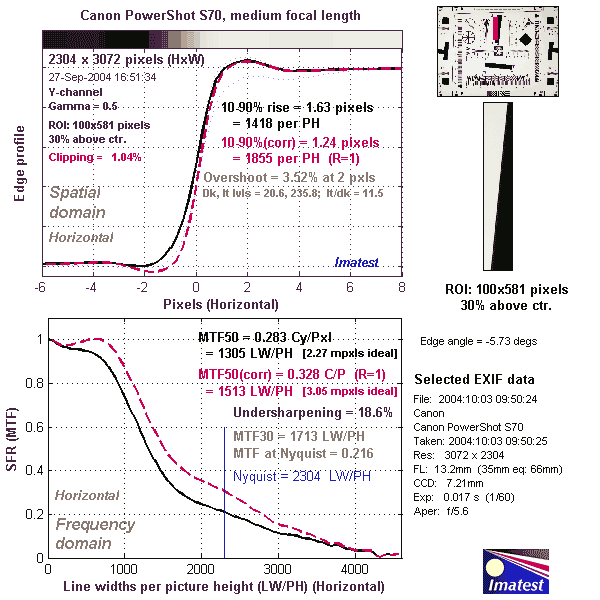
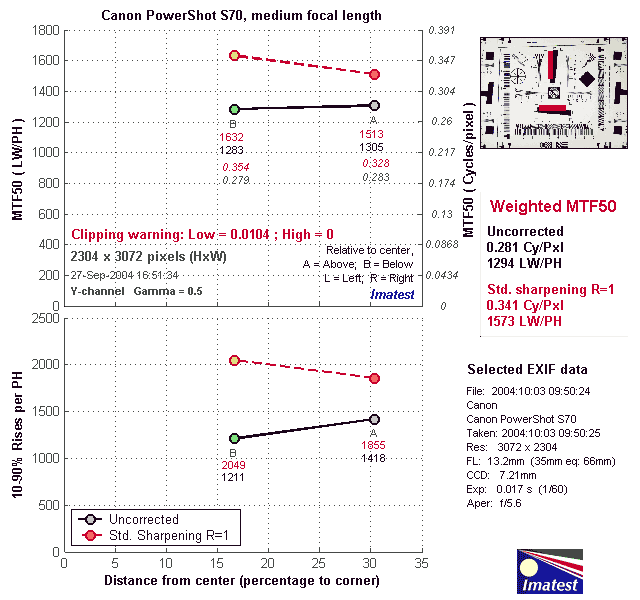

Follow Imaging Resource: